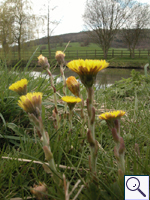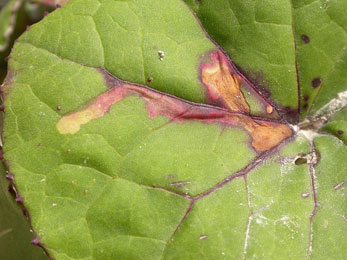|
||||||
|
TUSSILAGO. Colt's-foot. [Asteraceae] |
|
|
Colt's-foot (T. farfara) is the only species of Tussilago recorded in Britain. Nine British miners are recorded on Tussilago. The polyphagous agromyzid Liriomyza huidobrensis has been recorded in quarantine in Britain (Dom Collins (pers. comm.)). See also Liriomyza species in Glasshouses and/or Quarantine Interceptions. The pterophorid Platyptilia gonodactyla is recorded as a stem and flower feeder on Tussilago in Britain. A key to the European miners recorded on Tussilago is provided in Bladmineerders van Europa. |
|
Key for the identification of the known mines of British |
Note: Diptera larvae may live in a corridor mine, a corridor-blotch mine, or a blotch mine, but never in a case, a rolled or folded leaf, a tentiform mine or sandwiched between two more or less circular leaf sections in later instars. Pupation never in a cocoon. All mining Diptera larvae are leg-less maggots without a head capsule (see examples). They never have thoracic or abdominal legs. They do not have chewing mouthparts, although they do have a characteristic cephalo-pharyngeal skeleton (see examples), usually visible internally through the body wall. The larvae lie on their sides within the mine and use their pick-like mouthparts to feed on plant tissue. In some corridor miners frass may lie in two rows on alternate sides of the mine. In order to vacate the mine the fully grown larva cuts an exit slit, which is usually semi-circular (see Liriomyza huidobrensis video). The pupa is formed within the hardened last larval skin or puparium and as a result sheaths enclosing head appendages, wings and legs are not visible externally (see examples). See Key to non-Diptera. |
1a > Leaf-miner: An upper surface corridor mine, becoming strongly broadened and blotch-like. The mine can occupy a considerable part of a small leaf. Mines frequently merge and then accommodate several larvae. Pupation external, in the soil. Upper-surface corridor, in the end strongly widened and blotchy; may occupy a large portion of smaller leaves. Mines may coalesce, and contain several larvae then. Primary and secondary feeding lines very conspicuous (picture). Pupation outside the mine. Makes upper surface blotches. |
|
Acidia cognata (Wiedemann, 1817) [Diptera: Tephritidae]. |
1b > Leaf-miner: Full depth, initially a much branched corridor, irregular in width, in the end almost a blotch. The mine has openings by which part of the frass is ejected. The larvae frequently leave the mine to restart elsewhere. Older larva live free and cause window feeding, often erasing their old mines. In Coltsfoot also pseudo-mines are made, when the larva eats away the lower epidermis with the leaf tissue, but spares the dense hair cover. |
|
Phytosciara halterata Lengersdorf, 1926 [Diptera: Sciaridae]. |
1c > Leaf-miner: The mine begins as a long, quite narrow corridor, usually not far from the tip of a leaf segment. Usually this corridor follows the leaf margin for some distance, but it may also run freely through the blade and may then be stongly contorted. In the end the corridor is directed towards the midrib, where an elongated blotch is formed, overlying the midrib and some of the larger lateral veins. Frass in a nearly continuous line in the initial corridor, in scattered lumps in the later part of the mine. Primary and secondary feeding lines very conspicuous when seen in transparancy. Pupation outside the mine. The mine starts as a very narrow corridor, usually close to the tip of a leaf segment and following the leaf margin. The later section of the corridor approaches the main vein, where an elongated blotch is made with long broad finger like extensions that lay over the secondary veins. In the initial corridor the frass forms an almost continuous line, in the blotch it is distributed in large scattered lumps. In fresh mines the secondary feeding lines are clearly visible. |
|
Trypeta zoe Meigen, 1826 [Diptera: Tephritidae]. |
1d > Leaf-miner: A distinctive mine primarily above mid-rib, with irregular short lateral offshoots into leaf blade. Pupation external (Spencer, 1972: 51 (fig. 172), 55; Spencer, 1976: 270, 271 (fig. 486)). Branched, whitish, upper-surface corridor; main axis overlying the midrib; side branches overlying the main lateral veins. (In Campanula and Phyteuma the mine is much less branched, sometimes nothing more than a corridor on top of the midrib). Frass in rather long strings. Usually the mines begins as a long and narrow, shallow, tortuous lower-surface corridor that ends upon the midrib but otherwise is not associated with the leaf venation. Often this initial corridor is filled with callus, and then even less conspicuous. Pupation outside the mine. A linear mine on the upper surface, usually following the midrib and showing side branches along the veins. The frass is in strings. |
|
Liriomyza strigata (Meigen, 1830) [Diptera: Agromyzidae]. |
1e > Leaf-miner: A long linear greenish-white mine which can conspicuously widen at end, with frass in separate grains (Spencer, 1972b: 81, 83 (figs 264-5); Spencer, 1976: 522, 523 (fig. 915). Upper-surface, quite long corridor with irregular sides, in the end about 4 mm wide. Frass in discrete grains, alternating along the sides. Pupation outside the mine; exit slit in upper epidermis. A long narrow mine, widening at the end and often forming a secondary blotch. |
|
Phytomyza tussilaginis Hendel, 1925 [Diptera: Agromyzidae]. |
1f > Leaf-miner: The mine mine begins as a long, hairlike corridor. The last part of it runs perpendicular to a leaf segment. The part of the leaf that thereby is cut off Wiltshire, and here a large blotch is made. Frass scattered in the mine. Mine practically full-depth, yellowish green to reddish brown, with conspicuous secondary feeding lines. Pupation outside the mine. See also Seidel (1926a) for an extensive description of the mine. |
|
Stemonocera cornuta (Scopoli, 1772) [Diptera: Tephritidae]. |
|
Key for the identification of the known mines of British |
||
Note: The larvae of mining Coleoptera, Hymenoptera and Lepidoptera may live in a corridor mine, a corridor-blotch mine, a blotch mine, a case, a rolled or folded leaf, a tentiform mine or sandwiched between two more or less circular leaf sections in later instars. Larva may pupate in a silk cocoon. The larva may have six legs (although they may be reduced or absent), a head capsule and chewing mouthparts with opposable mandibles (see video of a gracillarid larva feeding). Larvae of Hymenoptera and Lepidoptera usually also have abdominal legs (see examples). Frass, if present, never in two rows. Unless feeding externally from within a case the larva usually vacates the mine by chewing an exit hole. Pupa with visible head appendages, wings and legs which lie in sheaths (see examples). |
||
1a > Leaf-miner: In the first instar the larva mines the leaves, forming short, irregular, blotch-like mines, but in later instars it lives externally, feeding in spun leaves and often twisting those of tender shoots. Larval head light-brown or yellowish brown, edged with black postero-laterally, ocellar area blackish; prothoracic plate black edged with whitish anteriorly; abdomen dull dark green; pinacula distinct, black, sometimes brownish but with black bases to setae; anal plate large, black (Bradley et al., 1973). Small, full depth mine without a definite shape; little frass. Some silk is deposited in the mine. The larva soon leaves the mine and continues feeding among spun leaves. |
||
|
||
| Cnephasia incertana (Treitschke, 1835) [Lepidoptera: Tortricidae]. | ||
1b > Leaf-miner: The mine is brownish and extends along the midrib, sometimes branching. Oviposition on top of the midrib. Immediately after emergence the larva gnaws a cavity in the midrib, and from there an irregular blotch is made adjacent to the midrib. The larva continues living in the midrib that is gradully hollowed out, making from there broad, brownish, full depth excursions in the blade. The mine contains much frass; most of it is concentrated in the area immediately bordering the midrib. Older, no longer occupied parts of the mine often split open. Mines mainly on the lower leaves. The slender larvae move surprisingly fast upon disturbance; when they rest (in daytime) they lie lengthwise in the hollowed midrib. Pupation outside the mine. |
||
|
||
Scrobipalpa acuminatella (Sircom, 1850) [Lepidoptera: Incurvariidae]. |
||
1c > Leaf-miner: The larva mines the leaves creating an irregular blotch. Forms an upper surface mine, with the surounding area turning purple. The frass is accumulated in one place in the mine and the larva may conceal itself under this. Initially a branching corridor, later more an elongate upper-surface blotch from the leaf base to the leaf margin, finally occupying a good part of the leaf. Most frass is deposited in one section of the mine, forming a crust below which the very agile larvae can retreat. |
||
|
||
|
||
Scrobipalpula tussilaginis (Stainton, 1867) [Lepidoptera: Gelechiidae]. |
| Last updated 07-Feb-2018 Brian Pitkin | ||


